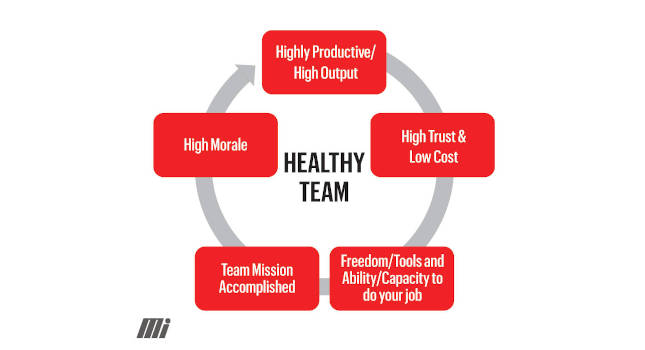Focus on and build healthier relationships within a workplace team

The world is full of conflicts both large and small. The typical industrial workplace is no different. Even within us there are conflicts between competing impulses.
Controlling what one eats is a struggle for many of us. Binge-watching favorite television series instead of exercising is another example. The costs vary depending on the activity and the level of participation associated with that activity.
Discussions with people in substance abuse rehabilitation programs often contain this advice: “Draw a line in the sand. Decide now, while you are in a safe environment. Understand that entertaining the thought of participation is one step in the opposite direction of where you want to be.”
This article focuses on building healthier relationships within a workplace team.
Team members’ conflicts
Consider having to resolve a conflict between team members. Was there a natural response that potentially produced undesirable results, extending a negative situation for an indefinite period of time, creating a downhill cycle or making things even worse? There is something simple that people can do ahead of time that will serve as a template for dealing with and overcoming the future conflict: Conduct a values survey.
A values survey is a simple exercise of proactively finding out what is most important to an individual in the plant. It allows discovery of a person’s principles or standards of behavior — one’s judgment of what is important in life.
For every employee on the team, find out the top five or so things they esteem the most. Keep that list in a convenient place. For some, those areas can be work/life balance, teamwork, creativity, trust, integrity, productivity, excellence, consistency or fun. Teams can find a list of values online, write them on a white board and have people circle their top values. Also available is this free online tool created by Motion Industries.
Know your team
Putting conflict resolution aside, this kind of exercise allows people to get to know their team better. Gaining insight concerning what is important to a person gives one a unique insight into how to relate to that person. Give them projects based on certain passions they select.
Avoid task misalignment. It may not be desirable to have the outgoing, interactive, people-person who values “community” keying data into an Excel spreadsheet all day, with no way of connecting with others. It also may not be ideal to have the highly introverted person that values “behind-the-scenes work” making daily presentations when what they value is a quiet, personal space where they can methodically work through their assigned tasks with limited social interaction. The maintenance individual who really values troubleshooting may not be properly assigned if performing a thoughtless job of simple assembly — all day, every day.
Some people in the learning and development world have had people go through personality profile assessments, such as the DiSC profile or the MBTI assessment. Knowing one’s strategy is half the battle. To quote Alan Lakein, “Planning is bringing the future into the present so that you can do something about it now.”
Before looking at how to resolve conflict, think of potential points of conflict that could arise in the plant’s operation, which may include:
- Differing philosophies regarding quality of products purchased as it relates to cost and life of product
- Differing philosophies on maintenance strategies: preventive/predictive maintenance versus run to fail
- Pressure from the plant manager for increased output versus resistance from maintenance for pushing equipment above recommended tolerances
- Scheduled downtime strategy versus reactive downtime strategy in crisis mode
- Conflicts as it relates to efficiency and waste
- Conflicts that arise with too much inventory on hand versus not enough inventory on hand
- Employee comfort: environmental temperature in the manufacturing process, cost of maintaining the preferred environment.
Template for resolution
By nature of the word “conflict,” at least one person is going in a direction or doing something that another person or group of people disagrees with, is against or does not like, causing tension between at least two people. The two parties are at odds with each other.
For the purpose of demonstration, assume that you, as a mid-level manager or executive, are managing the conflict between an unproductive employee and that employee’s confrontational supervisor. The lack of productivity frustrates the supervisor. The employee feels micromanaged.
No matter the conflict, begin addressing the situation independently with each party involved, so their concerns can be shared in a place without the conversation being escalated by the party on the other side. You are not solving anything here. You are listening.
Start by stating the values of the organization and affirm that you desire to uphold those values in your discussion. Our president at Motion Industries, Randy Breaux, made these clear for our organization when he moved into his role. Our values are to be “fair,” “ethical,” “inclusive” and “invested.”
Ask the executive management team what the values of the organization are. Ask the employee if any of their values that have already been identified during onboarding (remember the values survey?) are in conflict in any way with the established values of the organization.
More than likely, there will not be an obvious conflict between an employee’s values and the organization’s values, as the organization’s values will be broad, high-level values that can intrinsically include all the personal values listed by the team. If someone takes issue with being fair or inclusive, for example, this is an easy discussion. That person does not have a place on the team. More complicated issues arise when people are placed in the wrong “seats” or when more specific values held by team members conflict with each other. For example, the person who values time management, independence and efficiency is highly annoyed by the coworker who values fun and conversation, showing up unannounced for a seemingly trivial, unproductive 30-minute conversation. Likewise, the conversationalist that values relationships is bothered by the completely task-oriented, impersonal colleague.
For the situation at hand, ask the employee if there is a conflict between what that person values and the values of any person on the other side of the issue. That is when the real conversation begins. People perform based on their beliefs or what they value. Those values and beliefs lead to their behaviors. Behaviors produce results. You need different results than what you are getting from the collective behaviors, which must change. Beliefs and values are hard to change, but even that can take place, but it may not be necessary.
What is necessary is to understand a person’s “why” so what drives them can be understood, and then getting people outside of focusing exclusively on their needs. When they understand the needs of others, and ultimately, the needs of the business, they can maintain their individual values, even while working with individuals completely different from them. The diversity represented there will make a team stronger. Beliefs about people also will change for the better in that process. The boundaries and expectations need to be clearly established.
What we want and what we are getting
Once you are fully aware of the dynamics at play and everyone has shared their respective positions privately, lead a meeting with all parties involved. Begin on a positive note and demonstrate what a “healthy team” looks like, as it relates to the situation at hand, through a simple cycle graphic (see Figure 1).
Every action, environment or mindset listed in the model shown in Figure 1 will naturally lead to the next outcome in the circle. Feel free to enter the model at any given place. There is no starting point. It is a continuous flow.
For the next model, the phrase, “we lose” is placed in the middle. The reality of what is taking place in the example situation based on the hypothetical, independent conversations that were conducted is the basis of the model (see Figure 2).
There is cause and effect but determining whether the supervisor or the employee started the process is irrelevant. The focus is on a winning outcome, which requires the cycle to be broken.
Now, take your conflict and the behaviors associated with your situation and populate your own cause-and-effect models for a healthy team and a losing team. Remember to start on a positive note. Indicate that from your perspective, this is what a healthy team looks like, relative to the issue at hand. The parties involved may want to add additional entries to the healthy team model. There really should not be anything to dispute at this point.
Next, show and discuss the “we lose” model and detail the characteristics of the process in which you currently function. Paramount in this part of the process is staying away from personal attacks or phrases that put people on the defensive. Right now, attempt having this conversation in your head without using the word “you.” It’s tough. Use data and facts to prove the point.
- The department’s agreed upon goal was to have 10 projects completed by this time. What factors are causing us to only have three completed projects at this point?
- It was communicated that the data entry position is not a job that allows for flexible hours and that the time to report to work is 8:00 a.m. There are three instances where that has not occurred this week. What factors are creating this situation? Are there reasons this policy should be reconsidered?
- Output per hour is down 10% from last month and 12% under quota. I would like everyone’s thoughts on why we are seeing a downward trend, and I would like recommendations on ways to increase productivity.
You are not avoiding the conflict. You are directly addressing the issue. You are simply trying to tear down the walls that will naturally be built, showing people respect in the process, all the while, making your expectations clear.
Form a needs agreement and performance-improvement plan
The goal for the end of this conversation is to form a “needs agreement” between the parties in conflict. The “needs agreement” is formed by asking one question. “What do you need to perform your job with excellence?” Any sales course one will ever take will involve asking open-ended questions to obtain as much information from the customer as possible and repeating that information back to the customer to ensure you understand the full need and expectation, so you can deliver to the customer’s satisfaction.
That is exactly what we have done to this point in the conflict resolution. In our example:
- The employee expresses that they feel micromanaged, making it difficult to perform. They indicate that they need a little space, which will ignite their creative abilities, and performance will improve.
- The supervisor needs completed projects. The supervisor needs proactive communication from the employee as to where things stand, which will eliminate the need for the supervisor to constantly check in.
In our given example, the needs agreement will lead to the “performance improvement plan” document, or PIP. Based on the needs agreement, fill out the action items that all parties involved will take over a defined period of time and have everyone sign the document. In the example, we will agree to remove any unnecessary distractions the employee and supervisor have expressed is causing issues. This can even include eliminating interaction between the parties for a short, agreed-upon time. The purpose is to know if the employee can perform the duties of the job, and if the supervisor has the ability to trust the employee and not interfere in the process. You are eliminating excuses. Action items listed on the example PIP include:
- Project timeline expectations will be clearly communicated by the supervisor, and employee will confirm to the supervisor what he/she can expect to receive and when.
- The supervisor will not “check-up” on the status of projects until a project has gone beyond agreed upon timeline expectations.
- The employee agrees to proactively communicate project status as progress is made.
- The employee agrees to eliminate personal email and social media activities while on the clock.
Include the possible actions that will take place if the PIP is not successfully executed. When the agreed-upon time frame of the PIP passes, and if the process fails, you have the wrong person in the seat for one or more of the jobs at that time. The needs of the business require you to either train, realign or dismiss with appropriate documentation of your efforts. If training takes place and individuals remain in their respective seats, repeat the process at the training’s conclusion. If the process works, celebrate, and build on your new process and success.
Final thoughts
This process works if these steps are followed:
- Know the company’s values
- Identify the values of every individual on the team
- When conflict arises, ask:
- Are any of your values in conflict with the organization’s values?
- Are any of your values in conflict with the values of a coworker with whom you are having an issue?
- Hold a “healthy team” model and “we lose” model team meeting with all parties involved
- Form a needs agreement
- Form a personal improvement plan (with action items to take place over a specified time, and signatures of all parties involved). Note on the PIP what possible action(s) will be considered if this is not successful.
PIP failure = Training (and a repeat of the process), realignment/restructure (based on the skills and values of the individual(s) and the needs of the business), or dismissal.
PIP success = Healthy team.
Solving problems that exist between two parties can be much more of a process than a crisis, especially if you start the process before you are aware of the issue. That almost sounds crazy, but it leads to good organizational health. It simply requires proactivity in determining who you are as an organization and investing in people from the start. As you solve problems before they exist, you will find yourself enjoying a culture that hires right, truly values those hires, their unique abilities and insight and sees loyalty, going in both directions, flourishing.
ONLINE extra
For more information, visit Motion.com or Mi’s Learning and Development site.



